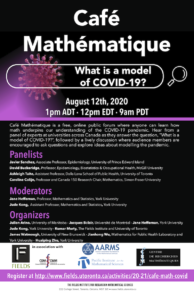
Events Search and Views Navigation
August 2020
PIMS/AARMS WORKSHOP ON New Trends in Localized Patterns in PDEs
Mathematical Theory and Applications to Physics, Biology and the Social Sciences– a Conference in Honour of the 60th Birthday of Michael J. Ward Localized spatial-temporal patterns commonly occur for various classes of linear and nonlinear diffusive processes. In particular, they occur in reaction-diffusion (RD) systems modeling quorumsensing (QS) behavior in biological systems, the initiation of root-hair tip formation in plant cells, and the spatial distribution of urban crime. Localization behavior also occurs in the biophysical context of calculating first passage…
Find out more »Café Mathématique: What is a model of COVID-19?
Café Mathématique is a free, online public forum where anyone can learn how math underpins our understanding of the COVID-19 pandemic. Hear from a panel of experts at universities across Canada as they answer the question, “What is a model of COVID-19?”, followed by a lively discussion where audience members are encouraged to ask questions and explore ideas about modelling the pandemic. Panelists: Javier Sanchez, Associate Professor, Epidemiology, University of Prince Edward Island David Buckeridge, Professor, Epidemiology, Biostatistics &…
Find out more »AARMS COVID-19 Seminar: Acadia Covid Modelling Group
Talk 1: Estimating underreporting of COVID-19 cases using fatality data Led by Margaret Hopkins Talk 2: Individual-based modelling of COVID-19 on the Acadia University campus with a realistic contact structure Led by the Acadia Modelling Group The Acadia Modelling Group consists of D. Currie, C. Hooper, M. Hopkins, R. Karsten, Y. Li, F. Mendivil, and H. Teismann. This is a virtual zoom seminar. If you would like to attend, please email the organizers for connection details.
Find out more »Atlantic GR Seminar: Nicholas Layden (Dalhousie) and Sharmin Akhter (MUN)
Geometric Horizons in the Szekeres Spacetime Nicholas Layden (Dalhousie University) A new conjecture for geometric horizons has been introduced which may provide a potential alternative to using apparent horizons and related surfaces for analyzing the dynamics of black hole spacetimes. In particular, using two examples of black hole formation in a collapsing universe in the Szekeres spacetime, the formation, evolution, and detection of geometric horizons are shown. In addition, a function for detecting apparent horizons in the Szekeres spacetime is…
Find out more »AARMS COVID-19 Seminar: Amy Hurford (MUN)
Modelling the impact of travel restrictions on COVID-19 cases in Newfoundland and Labrador Imported infections disproportionally contribute to coronavirus disease 2019 (COVID-19) outbreaks in regions where infection prevalence is low. On May 4th, Newfoundland and Labrador implemented travel restrictions whereby non-residents could enter NL only with exemptions. As the prevalence of COVID-19 was low at the time, it is likely that the travel restrictions substantially reduced the COVID-19 epidemic in NL. We fit a stochastic epidemic model to data describing…
Find out more »September 2020
Dalhousie-AARMS AAMP Seminar: Michael Ward (UBC)
Synchrony and Oscillatory Dynamics for a 2-D PDE-ODE Model of Diffusion-Sensing with Small Signaling Compartments We analyze a class of cell-bulk coupled PDE-ODE models, motivated by quorum and diffusion sensing phenomena in microbial systems, that characterize communication between localized spatially segregated dynamically active signaling compartments or "cells" that have a permeable boundary. In this model, the cells are disks of a common radius and they are spatially coupled through a passive extracellular bulk diffusion field with diffusivity in a bounded…
Find out more »Atlantic GR Seminar: Kam To Billy Chan (MUN)
The Reissner-Nordstrom Near Horizon Geometry is a Tangent Spacetime The near horizon geometry (NHG) of an extremal Reissner-Nordstrom black hole is obtained in conventional global AdS coordinates and in the coordinates of the parent spacetime. Geometrical objects, specifically Killing vectors and spacetime points, are mapped from the boundary and horizon of the NHG into the parent spacetime coordinates. The outcome is that the NHG is a tangent spacetime to the extremal Reissner-Nordstrom black hole’s degenerate horizon and that the degenerate…
Find out more »AARMS COVID-19 Seminar: Karen Phillips (Dept of Health and Wellness, PEI) and Javier Sanchez (Atlantic Veterinary College, UPEI)
The Covid-19 modeling experience in Prince Edward Island Since the beginning of the COVID-19 pandemic, Atlantic Canada and particularly PEI, has experienced a low number of cases with limited community spread. This epidemiological situation has created some unique and challenging opportunities for the modelers to address the questions of interest posed by public health officers. A simple SEIR model was developed to assess the magnitude of the consequences in terms of hospitalizations, PPE, and bed requirements under a set of…
Find out more »October 2020
Dalhousie-AARMS AAMP Seminar: John Toth (McGill University)
Title: Pointwise bounds for joint eigenfunctions of quantum completely integrable (QCI) systems Abstract: I will discuss some recent results on improvements in supremum bounds for joint eigenfunctions of QCI systems together with sharp exponential decay estimates away from the projections of invariant Lagrangian tori (ie. in the microlocally forbidden region). This is joint work with Jeff Galkowski. The Dalhousie-AARMS Analysis-Applied Math-Physics Seminar takes place on Fridays from 4 - 5 pm Atlantic Time over Zoom. If you would like to…
Find out more »Atlantic Graph Theory Seminar: David Pike (Memorial)
Perfect 1-Factorisations A matching in a graph $G$ is a subset $M \subseteq E(G)$ of the edge set of $G$ such that no two edges of $M$ share a vertex. A 1-factor of a graph $G$ is a matching $F$ in which every vertex of $G$ is in one of the edges of $F$. If $G$ is a $\Delta$-regular graph of even order then we can ask whether $G$ admits a 1-factorisation, namely a partition of its edge set into…
Find out more »
